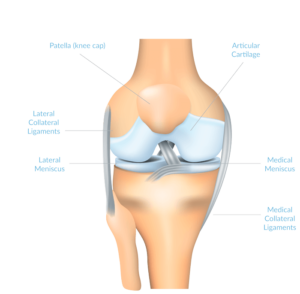
What is Arthroscopic Knee Surgery?
Arthroscopic knee surgery involves making a small incision through the skin so doctors can diagnose and treat knee problems. A small camera is inserted through the incision, which then displays images of the knee.
From here, surgeons can insert small medical instruments to perform a surgical debridement, which is the removal of dead, damaged or infected tissue. This process helps the healthy tissue in the area heal.
Surgical debridement of the knee can include:
- Removing torn areas of meniscus tissue
- Removing loose bodies
- Removing and cleaning up areas of cartilage damage
- Other minimally invasive procedures that do not include any repairs
What is a Knee Meniscectomy?
The surgical removal of a torn meniscus is called a meniscectomy, which is a type of arthroscopic knee surgery. The meniscus is a cushion for your knee and helps keep your knee steady by balancing your weight.
Meniscus tears are most common in the knee joints and are usually caused by twisting or turning the knee quickly.

Arthroscopic Knee Surgery Recovery
After a meniscectomy, your surgeon will likely advise physical therapy to put you on the best path toward recovery. The day after your surgery, you will need to see your physical therapist to:
- Change your dressings
- Take initial measurements
- Learn an initial home exercise program
Your physical therapist will also review information about what to expect, how to take care of your incisions and how to manage your pain. Handouts outlining everything you will learn will be provided.
Physical therapy appointments will be scheduled twice a week for approximately 6 to 8 weeks.
For the first couple weeks of rehab, patients will work on their limited range of motion. As you advance in your sessions, exercises that stretch and strengthen will ready your knee for a complete range of movement and ongoing recovery. It’s crucial to maintain consistency with your rehab appointments until your doctor gives you the all-clear, as this will optimize your healing outcomes.
Physical therapy rehabilitation helps:
- Minimize scar tissue
- Restore strength
- Regain range of motion
- Speed up your overall recovery
- Maximize return to full function and sport
- Reduce pain
Walking with Crutches
Some patients are released from the surgical center with crutches, but most can walk immediately. If you were given crutches, we will likely encourage you to stop using them as soon as possible.
Returning to Work & Daily Activities
Most people can get back to desk work, school or sedentary activity 3 to 5 days after surgery.
If your right knee was operated on, it may be up to 2 weeks before the knee is strong enough to hit the brakes to drive safely. For heavy work, it may take 4 to 6 weeks before the leg is strong enough to allow for working. You should never drive or operate heavy machinery if you are still taking prescription pain relievers.
Returning to Sports
Approximately 4 weeks after surgery, patients typically begin to perform higher level activities during physical therapy visits.
With your physical therapist’s guidance at 4 to 6 weeks, you will begin the gradual transition back to your sport. However, your surgeon will make the final decision about your full return to activity.
Post-Surgery Risk
After meniscus surgery, some patients experience another tear and need additional repairs. Patients may be more likely to experience another tear with inadequate rehabilitation or returning to activities too soon. With proper care, you can reduce the risk of re-injury and enjoy a healthy, active lifestyle.
Week-by-Week Rehabilitation

Weeks 0 to 2
During the first few weeks of your arthroscopic knee surgery recovery, you should be bearing weight as tolerated with crutches. You should be progressing to full weight bearing without the use of crutches.
Range of Motion (ROM)
- 0 to 125 degrees is expected
Knee Rehab Exercises
-
- Quad sets, glute sets
- Ankle pumps
- Hamstring and calf stretches
- Multi-angle isometrics for quads (90 to 60 degrees)
- Straight leg raises (multi-plane)
- Knee extension, open chain 90 to 40 degrees
- Patellar mobs
- Heel slides to tolerance
- Bicycle for ROM
- Passive range of motion (PROM) focused on improving full extension ROM
- Standing weight shifts
- Standing mini squats 0 to 30 degrees
- Low-level balance and proprioceptive exercises in standing
- Proprioceptive exercises focus on the ability to sense movement within joints.
Weeks 2 to 4
Range of Motion (ROM)
- Full ROM is expected
Knee Rehab Exercises
- Continue exercises from weeks 0 to 2 and all passive and active ROM
- Standing hamstring curls
- Bilateral protected ROM leg press
- Bicycle for ROM and light cardiovascular endurance with no resistance
- Stationary mini-lunge forward
- Step-ups
- Calf raises (standing bilateral –> unilateral)
- Wall slides
- Progress standing balance and proprioceptive exercises
- Pool walking program once incisions are fully closed
Weeks 4 to 6
Knee Rehab Exercises
- Continue exercises from previous weeks and all passive and active ROM as needed
- Step-downs
- Lateral step-ups
- Squats (increased ROM)
- Stair stepper machine <20 minutes
- Continue with exercises to achieve terminal knee extension
- Bicycle for cardiovascular endurance with light to moderate resistance
Weeks 6 to 8
During these weeks and the following weeks, there are no restrictions to activities of daily living (ADLs).
Knee Rehab Exercises
- Continue exercises from previous weeks
- Advance closed kinetic chain (CKCs) and functional exercises
- Begin walking program for cardiovascular endurance
- Gradually increase time on stair stepper for cardio endurance
- Functional movement screen (FMS) at eight weeks
Weeks 8 to 12
Knee Rehab Exercises
- Light plyometrics (jump training) if good hip and knee mechanics, gradually advancing
- Linear forward jogging in short bouts, gradually progressing jog intervals
- Perturbation training (also known as improving reaction times)
- May initiate gentle yoga
- Initiate elliptical for cardiovascular endurance
- Initiate forward agility drills (progressing to lateral as appropriate)
- Begin a strength and conditioning program, like Access Acceleration
Week 12+
During this time period, your surgeon must clear you before you’re able to return to your sport.
Knee Rehab Exercises
- Progress jogging program, intervals and/or sprint training
- Sport-specific training as needed: cutting, jumping, deep squats, etc.

